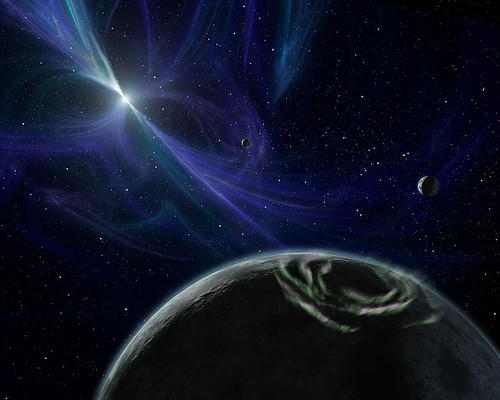Why infrared? (exoplanet edition)
- By Maggie Masetti
- October 24, 2013
- Comments Off on Why infrared? (exoplanet edition)
I’m not sure I’ve yet to meet a person who didn’t find the idea of planets around other stars fascinating. I’m no different. I grew up in an era where the only planets we knew about were the ones in our own solar system. When I went to college to study astronomy, I had Dr. Alex Wolszczan as a professor. He discovered the first ever confirmed extrasolar planets (or exoplanets) – and they were orbiting around a pulsar of all things. Yep, the first solar system found outside our own did not involve a main sequence star like our own. Unexpected to say the least.

Credit: NASA/JPL-Caltech/R. Hurt (SSC)
So now the question – why infrared? One of the main uses of the upcoming powerhouse James Webb Space Telescope will be to study the atmospheres of exoplanets, hopefully to find the building blocks of life elsewhere in the universe. But JWST is an infrared telescope. How is this good for studying exoplanets?
Well, let’s back up and talk about how JWST will be observing exoplanets. One method JWST will use for studying exoplanets is the transit method, which means it will look for dimming of the light from a star as its planet passes between us and the star. (Astronomers call this a “transit”.). Collaboration with ground-based telescopes can help us measure the mass of the planets, via the radial velocity technique (i.e., measuring the stellar wobble produced by the gravitational tug of a planet), and then JWST will do spectroscopy of the planet’s atmosphere.
JWST will also carry coronagraphs to enable direct imaging of exoplanets near bright stars. The image of an exoplanet would just be a spot, not a grand panorama, but by studying that spot, we can learn a great deal about it. That includes its color, differences between winter and summer, vegetation, rotation, weather… How is this done? The answer again is spectroscopy.
Spectroscopy is simply the science of measuring the intensity of light at different wavelengths. The graphical representations of these measurements are called spectra, and they are the key to unlocking the composition of exoplanet atmospheres.
When a planet passes in front of a star, the starlight passes through the planet’s atmosphere. If, for example, the planet has sodium in its atmosphere, the spectra of the star, added to that of the planet, will have what we call an “absorption line” in the place in the spectra where would expect to see sodium (see graphic below). This is because different elements and molecules absorb light at characteristic energies; this is how we know where in a spectrum we might expect to see the signature of sodium or methane or water.

Sodium in the atmosphere of the Hot Jupiter exoplanet of HD 209458, a 7th magnitude star, 150 light years away in the constellation Pegasus. Sodium filters out light from its parent star, and is detected using by analyzing absorption spectrum. Credit: A. Field, STScI
Space Telescope Science Institute scientist Dr. Christine Chen explained how the visible and infrared exoplanet transit observations differ, in a recent Reddit Q&A about JWST. “At visual wavelengths, the planetary atmosphere is characterized by looking at primary transits when the star passes behind the planet. In this case, we’re looking at star light that passes through the planet’s atmosphere and imprints absorption features. The situation is slightly different in the infrared in which measurements of the planet and star emission are compared with measurements of the star alone.”
This allows astronomers to search for these molecular features, or absorption lines in the spectrum.
Dr. Marcia Rieke, professor at the University of Arizona and principal investigator of JWST’s NIRCam instrument, added, “By taking a spectrum of the star alone, of the star + planet, and then differencing, you will be able see the absorptions. We may see water, methane, carbon dioxide, and carbon monoxide, for example.”
During a Tweet-chat with Nobel Laureate (and JWST project scientist) Dr. John Mather, he was asked if JWST could detect pollutants on exoplanets, something that would indicate industry. His answer: “We’re not expecting to find it, but JWST could detect CFCs.”
So that is why infrared – we’d like to find more planets, and more planets with atmospheres like ours. Perhaps JWST will be one of the right tools for the job.
More reading:
- JWST website – Planets & Origins of Life
- A New Frontier: Observations of Exoplanet Atmospheres with the James Webb Space Telescope
- NASA’s Next Space Telescope Could ‘Sniff’ Out Alien Planets
- How NASA’s James Webb Space Telescope Could Spot Earth-like Planets
- Coronagraphic Detection of Exosolar Planets with the James Webb Space Telescope (pdf)
- Characterization of exoplanets with the JWST/MIRI instrument
- Reddit Q&A with Women working on JWST


